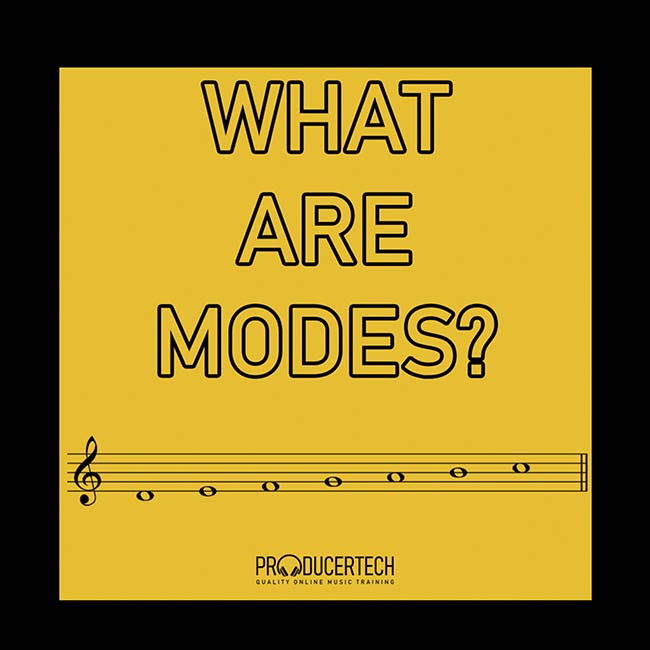Music has always been a journey. Some of us start as children, some as adults, but we all tend to tread a similar path when encountering music. It can be accessible to almost everyone, from banging a drum, strumming a guitar, or hitting a triangle.
After a few years of playing, whether it be an instrument or producing music, however, most musicians have to deal with an elephant in the room - music theory. Seemingly incomprehensible at first, we all realise at some point that we need to understand a bit more about the technicality behind the art. If you’re a beginner looking for an introduction to music theory, then look no further than our beginners guide to music theory.
Like music itself, theory Is an immense topic, and one which must be broken down into smaller, bite size segments. Today, we're going to take a look at modes. Without getting bogged down too much, we'll take a look at what modes are, where you can find them, and how you can use them in your music.
What is a mode?
To cut a long story short, a mode is a scale. All musicians utilise scales on a daily basis, and scales make up the bedrock of melodies and the hearts of songs. You might be thinking - well I already know all my scales, why would I need to know about modes?
Before we go on, we need to define something quickly. Major and minor are both modes themselves (the Ionian and Aeolian modes, respectively) but for the purposes of this article, we're going to discuss modes OTHER than the major and minor.
What make modes so interesting to listen to is exactly that; they're neither major nor minor. Most people associate music with emotions. In this case, major = happy, upbeat, triumphant, ecstatic. Minor = sad, melancholic, doom mongering, or even scary.
The other modes tend to fall somewhere in the middle, and as a musician myself, that's what had always fascinated me about them. I don't know what emotions to feel about the music, and as many musicians get used to major and minor, being surprised by how music can make you feel is something that can be greatly satisfying. As we've said before, you can go a lot further into detail, but this is an short summary for the purposes of discussing what lies ahead.
History
Before major and minor became the dominant modes in Western music in the 16th and 17th centuries, all the modes had a fair shot at the big time, and were represented a lot more in traditional and art music. Think to yourself what the sound of medieval music is to you. Or monks singing in an Abbey. Perhaps even an old folk song. Most people tend to describe this music as sounding; ancient; contemplative; mysterious; exotic.
Greensleeves is a great example of the dorian mode.
Why is this? You guessed it - they're all modes (or 'modal').
This connection with older music is often what informs our current, modern perception of modal music. Modes are also prevalent across the globe in all cultures, and can add to our unfamiliar-yet-familiar feeling about the music. Blues music is widely regarded as being the main ingredient and basis for almost all western pop music to this day. Blues has its own mode and that formulation was carried forward into jazz, rock, soul and pop and permeates the charts even to this day. So whether you realise it or not, you hear modal music on a daily basis.
Folk music
Although many forms and genres are modal, no musical movement is associated with modes than folk music. The dark, brooding, magical sound of folk can be attributed to modes, and in British folk particularly, the dorian mode.
The dorian mode is arguably the most popular of the modes, with a large amount of crossover and exposure in pop culture. Think Daft Punk's "Get Lucky" or Led Zeppelin's "Stairway to Heaven" for classic examples.
For more information on Dorian and the other modes, why not try our Advanced theory course.
Daft Punk’s "Get Lucky" is in the Dorian mode – and helps add to its innate catchiness and richness of sound. The reason folk music is a good area to study about modes is because the mode also influences the way in which the song is written.
Modal folk music focuses much more on melodic progression than harmonic progression – ie there are often little to no complex chord progressions in folk music, and this is often a signifying factor to get the modal sound.
Try it yourself – go out and listen to a variety of music, and see if you yourself can spot whether a song is modal or not.
Looking forward
Now we’ve looked at the roots of modal music and modes, how can we apply this knowledge to what we’re doing as producers and songwriters?
Well, as discussed earlier, modes are instant cheat code to making your music stand out. Because a lot of popular music now is in major or minor, writing music in modes can give you a cutting edge, as well as increasing the re-listenability of your music.
Lots of dance music, for example, works incredibly well written in modes. The droning, meditative modes lend themselves effortlessly to hypnotic genres like techno, trance and house. Furthermore, using world music modes can add flair and excitement into rhythm-based genres like Jungle, Drum & Bass and Garage.
So the next time you open the DAW, have a think about how you can incorporate modes into your next track!
If you wanted to hear some examples of more modal tracks, check out this Spotify playlist:
Looking to learn more about music theory, production and how to make it? You can find it all in one place with our all access membership, a subscription service that allows you to access the entire Producertech range.



